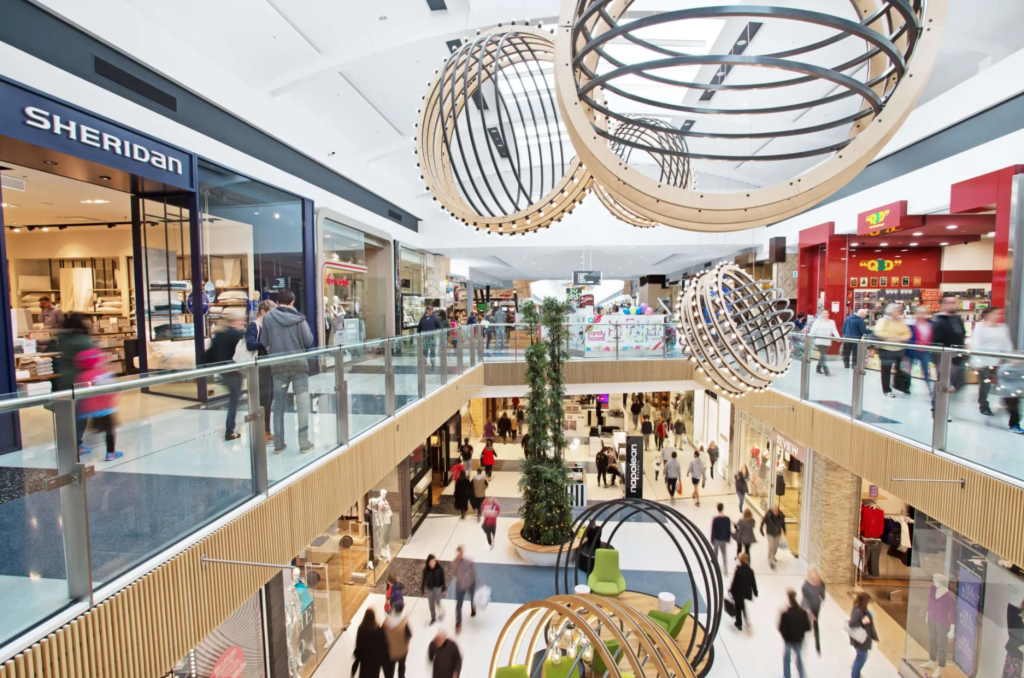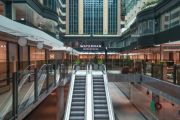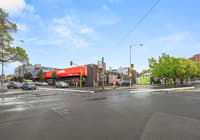
Shop till you drop: The retail revival that drove the commercial real estate market in 2025
After years on life support following a shift to online shopping – sent into overdrive by the COVID-19 pandemic – and a cost-of-living crisis, retail has made a Lazarus-like comeback to be the darling of the commercial real estate sector in 2025.
Spurred on by three interest rate cuts, low unemployment and steadying inflation numbers (for the most part), Australians opened their wallets and hit the shops, with businesses and investors alike riding the wave of positive sentiment.
As household disposable income grew, younger consumers were driving the increase in retail spending, according to Commonwealth Bank spending data for FY2025.
To accommodate shifting sector demands, retailers responded with innovative offerings to personalise the in-store experience. As demand for experiential retail grew, big brands such as Mecca led the way with their flagship store in Melbourne’s Bourke Street Mall, offering three floors of retail space and serviced by a team of approximately 300 staff trained as makeup artists, dermal therapists, fragrance sommeliers, hair stylists, and wellness practitioners.
Retail property was the most traded asset class in the first half of this year, with $6 billion transacted, up 17 per cent from $5.1 billion over the same period in 2024. This put the sector well ahead of the industrial ($5.6 billion) and office ($3.7 billion) sectors, according to the September Knight Frank Australian Retail Review.
Ray White Group head of research Vanessa Rader said that while deals generally took longer in 2025 as investors became more selective about their assets and focused on their due diligence, banks were open to lending in the commercial sector.
“Everyone’s feeling so much more confident about retail,” Rader said.
“There’s far more interest, from the small, little neighbourhood centres through to the really big, large format retail. This is off the back of good residential growth.”
Rader said recent data showed an increase in market confidence within the Australian commercial property sector, headlined by strong retail performance. She said investment in the commercial property sector was coming from both institutional capital and the private investor market.
“Retail has emerged as a clear market leader, posting 8.2 per cent total returns driven by 6 per cent income and 2 per cent capital growth,” she said.
“Sub-regional centres lead the sector at 8.8 per cent total returns with 1.9 per cent capital growth, while the private investor favourite, neighbourhood centres, delivered 8.3 per cent returns with 2.5 per cent capital growth.”
But it wasn’t just big-name store openings, innovative shopping experiences and an increase in consumer spending that had the commercial real estate market up and about this year.
If 2025 was the year of retail, pubs were a close second as rich listers, sports stars, and even the NRL got in on the action, with deals made and empires expanded.
Offices struggled to recover as businesses tried various new tactics to get workers back to their desks. Industrial continued to be a safe harbour for commercial real estate investment as demand outpaced supply for both large-format warehouses and micro-fulfilment centres, while data centres, or lack of them, became a hot-button planning issue.
And then there were islands. So many islands. For sale, for lease, for development – you name it, there was an island there for the picking.
Here’s what happened in the commercial real estate sector in 2025.
Get on the beers – pubs are still hot property
It started with the sale of the Hotel Australasia in Eden, the final asset of the collapsed Virtical Group. It ended with the renowned Melbourne nightclub Revolver going under the hammer.
In between, everything from the iconic cartoon-inspired Ettamogah Pub to remote Outback hotels hit the market.
“A couple of years ago volumes [of pub sales] got up to about $1.2 billion which is a really big year. I don’t think it’s going to be any bigger than that,” Ray White’s Rader said.
“The price of the pubs has obviously gone up an awful lot, so there’s a lot more, bigger sort of transactions that are occurring.
“There’s a story every second day [about pub transactions], so it has been a year for pubs and hospitality.”
And while the big-name establishments stole the headlines, local watering holes continued to undergo a quiet transformation.
Pubs in many Aussie suburbs are now unrecognisable from the sticky-floored, dimly lit bars of yesteryear, transforming into sophisticated, family-friendly destinations with more elevated food options.
James Ingram, co-founder and managing director of Peninsula Hospitality, said modern pub-goers were seeking “a relaxed and fun environment with an inviting atmosphere – like an extension of your living room”.
Tourism underpins hotel room growth
Australia’s hotels and accommodation sector didn’t see many big deals go through, but growth came from increased domestic and international tourism.
Rader said the latest data showed improved occupancy rates across hotel markets in all Australian cities.
“That just goes to show that people are traveling, and international travel is quite high coming into Australia,” she said.
“Our domestic travel is still doing well. Business travel has come off a little bit, but there are still conferences and all those sorts of things. So, I think the hotel market is doing pretty well.”
Rader said she expects to see more transactions in the hotel sector in 2026 from Singaporean and Malaysian investment.
As domestic travel improved, both ends of the accommodation sector benefited, with luxury hotels and lodges reaping significant gains. Meanwhile, savvy investors captured the other end of the market with the revival of the retro motel.
And who could forget “Australia’s worst motel”? The infamous Stay Inn in Coburg – known for syringes, bed bugs and even a shooting – finally sold following decades of controversy.
In a win for the housing crisis, private investors will repurpose the 2289-square-metre mixed-use block with double street frontage into much-needed housing.
Shoppers demand more; luxury retail delivers
As retail surged back into favour, modern consumers were increasingly demanding in-store experiences that went beyond the basic transaction.
Flagship stores, such as Mecca and Rodd & Gunn, took customers beyond the traditional shopping experience into a more curated experience, allowing them to get up close and personal with the brand.
“Social media has reframed the store as a stage,” marketing specialist Judith Silva said. “If a space isn’t visually compelling or story-driven, it risks being forgettable both in real life and online.”
The experience economy unpinned demand for premium shopping centres that delivered from a lifestyle perspective.
“These centres offer more than just retail; they provide curated experiences, dining, wellness, and entertainment, which makes them highly attractive to both consumers and brands,” Sam Embling, CBRE’s Pacific director of retail tenant representation, said.
“A flagship store in the right spot can act as a brand billboard, a community hub, and a conversion tool all at once.”
Major shopping events such as Halloween and Black Friday also continued to drive performance in the retail sector.
Offices reinvent themselves to lure workers back
Australians continued to work from home in 2025, keeping office-sector performance low.
More than 6.7 million Australians – or 46 per cent of the country’s employed – work from home at least some of the time, either paid or unpaid, according to Roy Morgan research released in August this year. The remaining 54 per cent work entirely in the workplace.
With many businesses introducing return-to-work mandates, many workplaces are looking for ways to help people transition back to the office. Office amenities – plush fitouts, cafes and wellness options – along with a rethink around how spaces are configured, were top of mind for landlords looking to drive up office occupancy.
Meanwhile, new research from CBRE showed the country’s office market was “not ready for net zero”, with genuine net-zero-ready buildings representing only a small fraction of the total stock.
Only 3.2 per cent of NABERS-rated stock in the Sydney CBD is fully electric, a stark contrast to the corporate occupiers demanding 5.5-star ratings, green leases, and verifiable decarbonisation pathways.
This will become increasingly important with Australia’s ESG reporting standards requiring large entities to report on climate-related financial risks and opportunities, including their greenhouse gas emissions and energy use.
While prime CBD office stock performed well, lower-grade office stock struggled to compete.
However, Ray White’s Rader predicts a shift in the office market next year as smaller businesses look to consolidate their budgets where they can.
“As much as the death of the secondary grade office buildings anywhere is the narrative that’s been going around for a long time – and I’ve been saying that too – I think there’s going to be a place for those high B-grade assets that can provide affordable rent,” Rader said.
“At the end of the day, all the ESG requirements around sustainability and all the social governance around being in an asset that ticks all those boxes, a lot of small businesses, or family businesses, don’t have all of those same requirements.
“And if they need to cut their costs in their accommodation, they will probably move to a different building.”
Industrial a safe harbour
The industrial sector continued to appeal to investors, especially “mum and dad investors” seeking relief from rising costs in residential property investment.
Demand continued to outstrip supply across many assets, and data centre planning became a hot topic as the rapid adoption of AI drove a new wave of demand.
CBRE forecasts the country’s data centre investment will grow by about 50 per cent in the next four years, reaching $46 billion in 2029, based on committed projects.
Rader said construction in the sector may see a slight softening of short-term rental growth in the future, but land supply issues would likely continue.
“It’s going to be very location sensitive. If it’s [the asset] is going to be right on a major road, or it’s going to be have good access, say, to Western Sydney Airport, or good access to a port, or it’s in the inner market where there is really tight vacancy, those ones will do really well,” she said.
“Industrial will just keep going along. We’re going to continue to need industrial.
“If you’re in certain locations, it’s still very attractive to an occupier-buyer market. That private investor, mum and dad investor market, that’s not going away. Particularly with the interest rates that have come down.”
Island life is calling
And if the commercial property sector became a bit much in 2025, there was always the option to retreat to your very own private island hideaway.
From rugged Tasmanian outcrops in Bass Strait to resort-ready spots on the Great Barrier Reef, there were plenty of opportunities to embrace island life.
Thinking of buying your own private island? Well, there are several incentives available to commercial operators looking to build resort-style developments.










